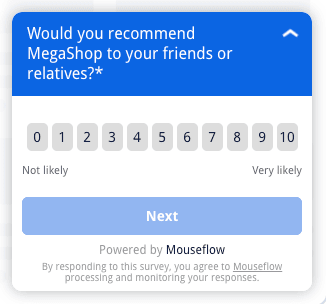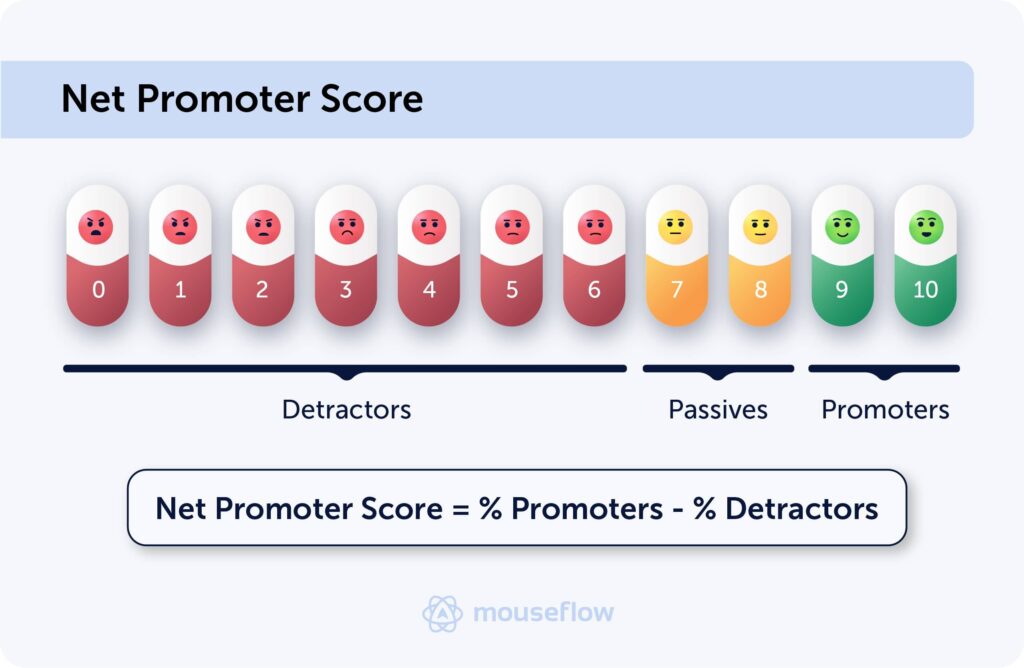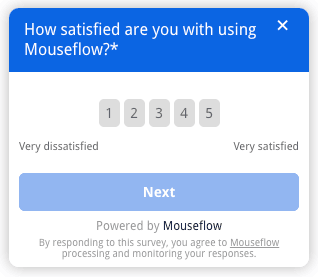Are your customers championing your products or services, or do they tend to talk their colleagues out of using them? You don’t know until you ask, and Net Promoter Score (NPS) is one of the best instruments to get a good perspective on it.
What is Net Promoter Score (NPS)?
Net Promoter Score is a metric used to evaluate how customers feel about a product or service using a simple scoring system. It focuses on one key question: “How likely are you to recommend our product or service to others?” Customers answer this question by giving a rating between 0 and 10. Often, there are more questions after this to understand why customers gave those ratings.

Example of an NPS survey with Mouseflow’s feedback survey tool
The Scoring System behind NPS
Based on the number between 0 and 10 that the customer gives, they belong to one of the three groups:
- Promoters (Score 9-10): These customers are loyal, enthusiastic, and are likely to actively promote your brand, thus positively impacting your bottom line.
- Passives (Score 7-8): Satisfied but unenthusiastic customers who are vulnerable to competitive offerings.
- Detractors (Score 0-6): Dissatisfied customers at risk of detracting others from your brand due to their negative experiences.

How to Calculate NPS?
After you’ve collected the responses and divided the respondents into groups, calculating NPS is quite straightforward:
- Calculate the percentage of respondents in the Promoter and Detractor categories.
- Subtract the percentage of Detractors from the percentage of Promoters.
- The resulting figure, which ranges from -100 to 100, represents your NPS.
The Goals of NPS
Originally developed in 2003, NPS was designed to provide a clear and concise measure of customer loyalty. It emerged from the need for a more straightforward, yet effective approach compared to traditional customer satisfaction (CSAT) surveys.
NPS is not just about scoring; it’s also used to:
- Gain deeper understanding of customers.
- Address and reduce customer churn.
- Quantify the influence of word-of-mouth referrals.
- Benchmark your customer experience against competitors.
- Drive improvements in products and internal processes.
- Unite the organization around a single, customer-focused metric.

NPS vs CES vs CSAT
NPS is a widely used metric (or, you can say, a tool for analyzing customer feedback), but it’s not the only one.
There’s also Customer Effort Score (CES), which focuses on the effort customers exert in interactions with a brand.
And then there’s Customer Satisfaction Score (CSAT), that’s calculated as an average score given by customers, when asked to rate their satisfaction with products or services on a scale from 1 to 5.

Example of a CSAT survey we run inside Mouseflow app
Each metric has its strengths and can be used in conjunction to provide a well-rounded view of the customer experience.
📖 Check out our article about the types of user feedback to learn about what other feedback you can (and, perhaps, should) collect.
NPS Case Studies: Highlighting the Impact of NPS on ROI
Allianz Group’s NPS Strategy:
- Allianz Group uses NPS to measure broker sentiment towards their business and to benchmark their performance against competitors. Allianz has been putting a lot of effort into improving their NPS across its companies. Their position is that only by combining the voice of business and the voice of customer can business achieve significant growth.
Northwestern University’s Research:
- Their study of a hotel chain showed that a 10% increase in efforts to satisfy customers resulted in a 22% increase in customer spending per hotel visit.
ASDA’s Mobile Technology Driven by CX:
- The ASDA app, focused on making shopping quicker and more convenient, led to a significant rise in loyal, repeat customers – according to their internal survey, ASDA app shoppers were twice as likely to become loyal customers.
Triumph’s Interactive Retail Environment:
- Triumph’s ‘Triumph Essence Fantasy Mirror’ in their ‘Fantasy Booth’ that allowed you to “try” lingerie without removing a single item of clothing is an example of how an interactive retail environment can enhance CX. It led to a 50% increase in sales in the first week after the campaign launched.
How to Use NPS Surveys for CX Optimization
There are several best practices to follow if you want to get as much as possible from NPS surveys. Here are five of the most important ones:
- Place surveys strategically: Implement NPS surveys at critical touchpoints in the customer journey to gather relevant and timely feedback. It could be after a purchase or a customer service interaction, for example. Learn more about when and where to use surveys.
- Analyze NPS on a granular level: looking at NPS not just across the company, but per business branch, product, feature, etc., can help you identify specific areas for improvement, such as product features, customer service, or user experience.
- Segment and personalize: Use NPS data to segment customers and tailor experiences based on their feedback.💡Expert tip: According to McKinsey, higher levels of personalization usually result in higher customer satisfaction.
- Analyze trends: Continuously track NPS over time to identify trends, measure the impact of changes, and adjust strategies for ongoing improvement. It should not be a one-off endeavor.
- Engage employees: Involve employees in understanding and using NPS feedback to build and improve a customer-centric culture within the organization.
Conclusion
NPS surveys can be a very useful tool for quantifying the impact customer experience optimization has on ROI. By paying enough attention to measuring, analyzing, and improving NPS, businesses can increase customer loyalty, drive growth, and make informed, data-driven decisions.


